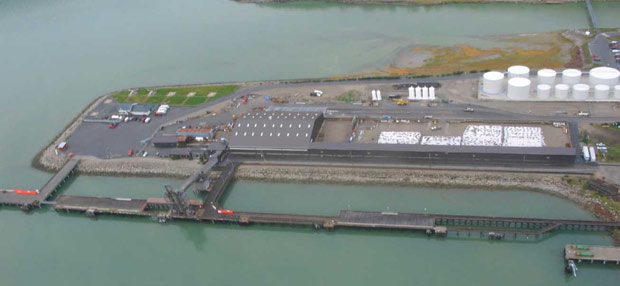
Skagway Ore Terminal/AIDEA photo
Skagway is getting closer to addressing long-standing lead contamination in the harbor. The Alaska Department of Environmental Conservation is taking a more proactive approach to motivate clean-up of the ore basin. DEC brought together the complicated web of harbor owners and users to meet in-person and work towards a solution. The most recent meeting happened last week.
On Nov. 21, representatives from DEC, the Skagway Borough, White Pass and Yukon Route Railroad, and other stakeholders sat down together in Anchorage. The meeting lasted about an hour and consisted mostly of a presentation from Golder Associates, an environmental engineering company.
“We reviewed 13 reports that covered a span of almost 30 years that were previously done for the ore basin,” said Golder hydrologist Tamra Reynolds.
Golder was hired by White Pass to analyze previous studies and make a recommendation on the best course of action.
“It’s been a highly studied site, but there hadn’t been a consolidation of all the work,” said White Pass executive Tyler Rose.
His company is involved in this because they lease the ore terminal land from the municipality, which owns it. White Pass and the municipality are just two of several ore terminal stakeholders. Others include the Alaska Industrial Development and Export Authority, Mineral Services Inc., and the Yukon’s Capstone Mining.
So, Golder reviewed the existing information, and…
“Their conclusion was that they needed to do more analysis,” said Steve Burnham Jr., a Skagway Borough Assembly member who attended the meeting.
Golder is recommending more research before doing anything with the contamination. Reynolds says they want to do a risk assessment.
“In order to clean it up, you need to know where the areas of high risk are,” she said. “And then you can identify the best way to clean it up.”
Reynolds says there isn’t just one way to clean up a contaminated site.
“The way that’s been proposed to date is dredging,” Reynolds said. “Dredging is often worse for the ecosystem because you’re then suspending it into the water as you’re pulling it out. So what we want to make sure is we don’t cause more harm to the environment than potentially other solutions.”
The risk assessment would involve studying the mussels, crabs and fish in the area for toxicity.
“We want to take away those question marks,” said Reynolds. “We want to see if there are potential health affects, rather than just speculation about it.”
If the risk assessment finds there is only danger in certain ‘hot spots,’ remediation might be limited to those sections. Or, if it finds no risk, there might not be any clean up needed.
But Assemblyman Burnham says the question of risk has already been answered.
“We have done enough testing on the waterfront and we’ve gotten the result showing us that there is a risk to leaving the contamination there,” Burnham said.
Kara Kusche is the DEC project manager for the site. She realizes that some in Skagway want the clean-up to happen as soon as possible. But she says the risk assessment plan is progress compared to the stalemate that’s lasted for much of the past year.
“We are actually very happy,” Kusche said.
She says this is what DEC wanted when they gathered the various parties involved in the ore terminal in August. DEC directed them to come up with a solution. White Pass taking the initiative and paying for Golder to evaluate the current data and prepare for a risk assessment is a good step forward, Kusche says.
“We would be able to make some decisions about whether it’s best to leave contamination in place or treat or remove contamination,” Kusche said.
In the past, progress has stalled because there are different ideas about who is culpable for the clean-up. But DEC told the municipality, White Pass, and other groups that all of them are ‘potentially responsible parties.’
The next step is for Golder to draw up and present a work plan to DEC and the other parties in early 2017. The company says it could complete its testing and finalize the data by the end of 2017.
That timeline doesn’t sound acceptable to everyone. Assemblyman Burnham says if a risk assessment does happen, it needs to be faster than that. He doesn’t want to kick the can down the road another year.








